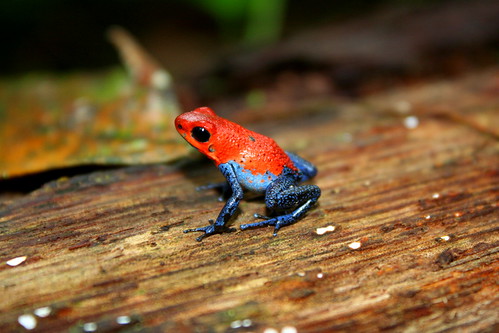[Article] 無證據支持箭毒蛙的體色多樣性影響其生存率或被捕食率
原文標題:No evidence for differential survival or predation between sympatric color morphs of an aposematic poison frog
摘要 [原文網址]
Because variation in warning signals slows down the predator education process, aposematic theory predicts that animal warning signals should be monomorphic. Yet, warning color polytypisms are not uncommon in aposematic species. In cases where warning signal variants are separated geographically, adaptation to local predators could explain this variation. However, this cannot explain the persistence of sympatric polymorphisms in aposematic taxa. The strawberry poison frog (Oophaga pumilio) exhibits both allopatric and sympatric warning color variation in and around the Bocas del Toro archipelago of Panama. One explanation that has been proposed for the rapid diversification of O. pumilio coloration in this archipelago is low predation; if island populations have few predators, stabilizing selection would be relaxed opening the door for diversification via selection or genetic drift. Using a combination of mark-recapture and clay model studies, we tested for differences in survival and predation among sympatric red and yellow color morphs of O. pumilio from Bastimentos Island. We found no evidence for differential survival or predation in this population, despite the fact that one morph (red) is more common and widely distributed than the other (yellow). Even in an area of the island where the yellow morph is not found, predator attack rates were similar among morphs. Visual modeling suggests that yellow and red morphs are distinguishable and conspicuous against a variety of backgrounds and by viewers with different visual systems. Our results suggest that general avoidance by predators of red and yellow, both of which are typical warning colors used throughout the animal kingdom, may be contributing to the apparent stability of this polymorphism.
文中所研究的箭毒蛙是草莓箭毒蛙,草莓箭毒蛙是市面上很熱門的一種箭毒蛙,主因就在於牠有很多種不同的顏色,雖然在原產地不同的色型分布在不同的區域,但還是有些地方的族群是有多色型的,這研究就去找了這個地方來做一些分析。
好了,有這麼多顏色就奇怪了,因為警戒色理論告訴我們,為了要讓捕食者印象深刻,應該同一種顏色越多越好,怎麼會冒出這麼多種不同的顏色呢?作者選了一個地點,這個地點有紅色與黃色兩種色型,他們做了長達六年的族群捉放,為的是知道這個區域兩種色型的比例,也利用模型去測試被捕食率,結果發現兩種色型間的被攻擊率沒有差異,六年的捉放資料也告訴我們紅與黃的比率沒有太大的改變。
於是作者推出一個結論:這可能是因為兩種顏色都是警戒色的關係,所以才會這麼穩定,如果其中一種不是的話,那種顏色可能就會消失。
好像有點合理,如果有警戒色與非警戒色的比較就更有說服力了。
另外要說明一點,雖然此研究的結果是這樣,但有更多的例子是一個族群同時有警戒色與非警戒色的個體,但相關研究似乎非常少。







0 comments